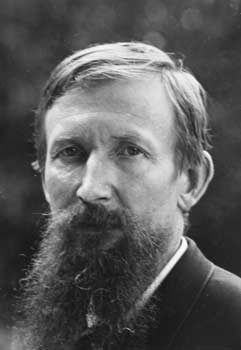VIKTOR VASNETSOV (1848–1926)Â
Viktor Vasnetsov, the elder brother of Apollinary Vasnetsov, was born in the village of Lopyal, the Vyatka province (today the Kirov region). He studied in St. Petersburg at the Society for the Encouragement of Artists (1867) and at the Academy of Arts (1868–1874). Vasnetsov was a painter, a graphic artist, a decorative and applied arts designer, a scene-painter, an architect and a pedagogue. He was a member of the Society of Traveling Art Exhibitions (since 1878) and of the Union of Russian Artists (since 1918), full member of the Academy of Arts (1893). Vasnetsov was a participant of the Abramtsevo Colony since the very beginning (1878). Savva Mamontov commissioned the artist to paint three pictures "Three Queens of the Underground Kingdom" (1879–1881, the State Tretyakov Gallery), "Fight of Scythians and Slavs" (1879, The State Russian Museum), "Flying Carpet" (1880, the Nizhny Novgorod State Art Museum). In 1879–1885 the artist lived firstly in the village Akhtyrka near Abramtsevo and then in the Abramtsevo estate where he worked at the paintings "The field of Igor Svyatoslavich's battle with the Polovtsy" (1880), "Alyonyshka" (1881), "Bogatyrs" (1881–1898, all in the State Tretyakov Gallery). He designed the project for the Abramtsevo Church of the Savior (together with Vasily Polenov, 1881–1882), took part in the construction works and made the interior designs, painted the iconostasis images "Sergius of Radonezh" (1881) and "Virgin and Child" (1882). The artist made the project for the "Hut on Chicken Legs" (1883) and the chapel adjoining the Abramtsevo Church (1891–1892). He collected articles of folk art, designed furniture and ceramic items for the Abramtsevo workshops and the Abramtsevo Ceramic Plant. In particular he was the author of the sketch of the majolica frieze for the State Tretyakov Gallery (1903). Vasnetsov participated in the amateur performances and made sceneries for them as well as costume designs for the Russian Private Opera of Savva Mamontov. After the October Revolution, 1917, he took part in the establishment of the Abramtsevo Museum. Today the Museum keeps pictures and graphic works by the artist, articles of decorative and applied arts made to his designs and the sketches for the sceneries and costumes. Â
View the embedded image gallery online at:
http://www.abramtsevo.net/eng/painters/viktor-vasnetsov-.html#sigProGalleria209b246fa5 |


